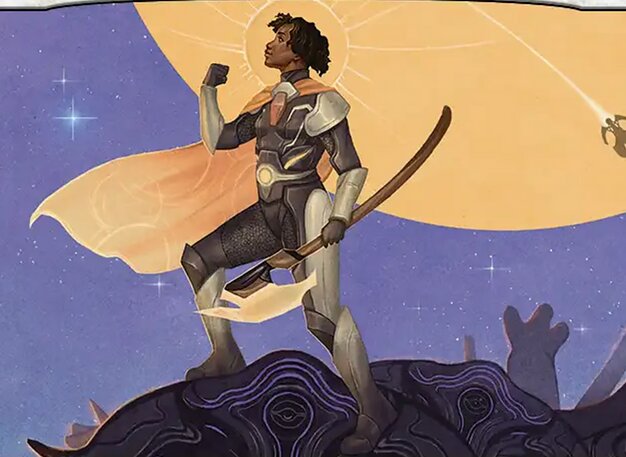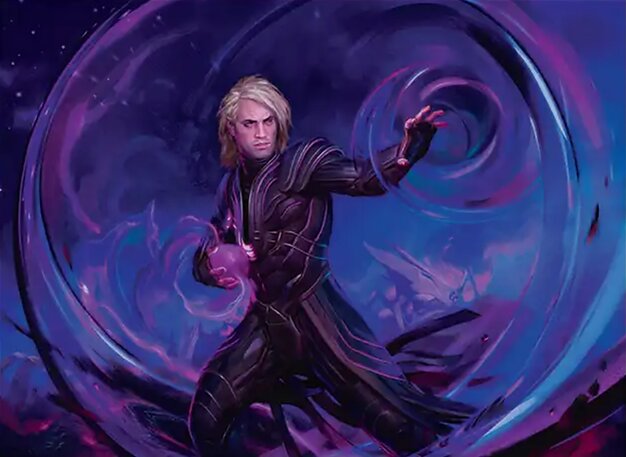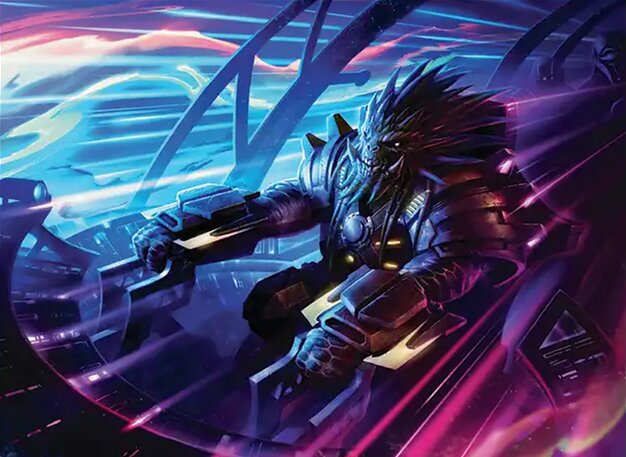Perhaps what I love most about science fiction is its ability to bring old questions to us in new language, to dream new dreams with old ideas, and inspire new futures out of ancient problems. As Ryan Carroll has already noted, Edge of Eternities’ novella-length story, masterfully written by Seth Dickinson, paints the struggle of the Monoists and Summists “in the register of cosmic mysticism” weaving the apocalyptic horizon of black holes and supernovas into competing messianisms. As Caroll puts it,
This is not “Good is cool and evil is lame” philosophy. This is human fallibility grappling with enormous questions, the kind of questions that necessarily resist literalistic language and push toward the counterintuitive enormities at the heart of our universe.
In other words, Dickinson’s story utilizes metaphysical and existential conflicts alongside poetic and religious language to create a “difficult” but engaging work of science fiction that asks its questions in ways that are alien and fantastical but also strikingly familiar. This piece is a syllabus: a list of these questions and topics, partially formed; an introduction to discussions that I am pointing out, but leaving undeveloped.
The Best of All Possible Multiverses?
A Syllabus on Philosophy of Religion and Ethics in Edge of Eternities
Unit 01: Euthyphro at Uthros: Haliya Questions the Sum
Very often, at the beginning of an undergraduate ethics class, I will ask my students to read Plato’s Euthyphro. Euthyphro is a dialogue, a conversation between the titular character and Socrates, which gives rise to the famous “Euthyphro Dilemma:” Is something good or right because God (or gods) commands it, or does God command it because They perceive that it is good? For classical (western) theists, neither horn of this dilemma is satisfying. The first horn seems to make morality arbitrary, dictated by the whims of the divine (a form of “Divine Command” theory); the second challenges divine omnipotence by making even God or the gods subject to a greater external concept of Good or Right.
In Episode 8 of the Edge of Eternities Story, the Summists’ ship, The Sundog, kills thousands of innocent Kav, burning them alive because of their proximity to the Endstone. The Endstone, a mysterious artifact that has the ability to alter causality and rewrite the past to move toward a more favorable future, is estimated to be so dangerous to the Sum that nearly any calamity, any act of even mass violence, seems to be justified, even necessary, if such a thing could prevent the Endstone’s use. Nevertheless, the Summists leave Haliya, even more proximate to the stone, alive. Haliya feels in her conscience that the destruction of the Kav is evil, and cannot square this realization with her faith’s doctrines, which teach her that the Sum is good, and promotes life and light.
The Sum is not like the gods of Olympus; it is not capricious, nor does it seem that it has a will, per se. But the second horn of the Euthyphro’s dilemma is still a live question: does the concept of goodness and right transcend the Summists utilitarian calculations? In the face of a glaring atrocity seemingly commanded by divine fiat, do we judge the divine to be evil, or only our understanding of it?
Unit 02: The Problem of Evil and The Best of All Possible Worlds Theodicy
Both the Monoists and the Summists face the future with an incredible, empirical certainty. The Monoists know that the entropic force of the universe will eventually win out; universal heat death will happen. The Summists, with the aid of mathematical calculations, aim to increase life, to add to the Sum, and postpone the end of the world for billions of years. And yet, something seems off.
Alpharael rejects sekhar, doubting the reality of the New Eternity, and chooses instead to embrace his life and live it. Haliya, witnessing the annihilation of innocents in the name of her religious cause, cannot rationalize the amount of suffering and evil seemingly necessary for the Sum. As I mentioned above, she initially doubts the reliability of the Summists before she doubts the goodness of the Sum – surely, there was an error in calculation, surely there can be a correction. This is a variation of the “problem of evil,” which is often stated something like this: “How can a deity who is all-knowing, all-good, and all-powerful permit so much evil to take place? If the deity is all-knowing, they know the evil is happening (maybe even before it happens). If the deity is all-good, they’d want to stop the evil. If the deity is all-powerful, they can stop the evil. So the fact that so much evil happens means that either the deity is not all-knowing, not all-good, or not all-powerful.”
Gottfried Leibniz, in his Theodicy, attempts to solve this problem with the notion that the world that is is in fact the best of all possible worlds; that is to say, the world could have been much worse, but it cannot, in fact, be better. . An omniscient, omnipotent, omnibenevolent God would always structure reality in such a way as to have the best possible effect. If you find yourself raising your eyebrow at this argument, you aren’t alone – 40 years after the publication of Leibniz’s Theodicy and Monadology, The Lisbon Earthquake of 1755 and the Seven Years’ War seemed to give the lie to Leibniz’s optimism. The French writer Voltaire famously satirizes this optimism in Candide, in which Dr. Pangloss (a parody of Leibniz) invokes the “best of all possible worlds” idea over and over as he and Candide are beset by catastrophe after catastrophe: forced from their home, conscripted into military service, flogged, diseased, shipwrecked, arrested for heresy, and on and on.
Haliya’s crisis of faith is familiar, based on a classic objection to theistic faith – horrible, human-caused calamities like the dropping of atomic bombs and genocides leave us wondering how such evil could be permitted, even if human agency is often cited as the cause. It is far harder, however, at least historically, to blame human agency for massive natural disasters.
Unit 03: Tannuk’s Trolly Problem
…but even if someone is to blame, is a disaster morally evil? In Episode 6, Tannuk tells Sami,
“Disasters are fair. Disasters are random. A thousand years ago, a stampede was a disaster. Now, building a corral to divert the stampede onto your neighbor, that’s evil. […] Things fall out of the sky and kill you on Kavaron. Some idiot might be responsible, they might’ve neglected the safe way to do things, but that idiot didn’t mean to kill you. They just caused a disaster, and the disaster claimed you. You can’t avenge a disaster. You can’t punish a disaster. You can only try to stop it or save people from it. It’s when you try to steer the disaster that you cross into wrongdoing. Because then you’re violating its fairness.”
“Steering a disaster” sounds very much like the famous “Trolley Problem,” a moral dilemma first articulated by Philippa Foot in her famous 1967 essay on the doctrine of “double effect.” Foot articulates a basic scenario of a runaway trolley, the disaster, headed toward multiple people. The trolley can be diverted to a different track by a bystander, and in that case, the trolley would only kill one person.
Tannuk was once that bystander. As a bolide – an exploding meteor – headed for the Kavaron city of Summotank, he gave command to fire on it, causing the meteor to fall sooner, on a much smaller settlement. He sacrificed a relative few to save many. For the Kav, this was a major ethical violation. By intervening, Tannuk went from being a neutral bystander to the cause of twenty-five thousand deaths. Nevermind the four million lives he spared.
When I teach moral theology, this concept, which is shared by classical Catholic ethics, seldom reaches sympathetic ears. Our moral intuitions seem to tell us that sacrificing one for the sake of the many makes good sense. According to classical Classical ethical first principles, humans are to do good and avoid evil, and evil may never be done knowingly and willingly, even if it’s in pursuit of some greater good. It is better, according to at least traditional Catholic ethicists, not to intervene than to place one’s hand upon the switch, and choose the death of another.
This isn’t exactly the Kav’s reasoning, however. Much like the faith in entropy or probability seen in the Monoist and Summist faiths, the Kav accept that disasters simply happen. Sometimes, it’s just your time. Prepare if you can, and then accept that no matter what, disaster happens. Putting his thumb on the scale meant that Tannuk – not fate or chance – became the engineer of Kav deaths.
Unit 04: Human Agency and Divine Causality
…or did he? The Endstone has a goal of its own, and re-orders possible pasts to create the present it needs to achieve a throughline to its desired future. Since Tannuk is now in proximity to the Endstone, this possible present has come about from a past that enabled it to be. How can a person be certain of their agency when artifacts can alter the events of the cosmos?
Some philosophers wonder whether humans have choice at all, or just the illusion of choice. We are made of matter, after all, and matter reacts to other matter in predictable ways. It seems like we are consciousnesses, in command of our actions, but at the same time, neuroscience (at least last I knew) estimates that we are a highly complex electrochemical organism, with quintillions (even sextillions) of chemical reactions happening per second.
Classical Christian theism has wrestled with the question of divine causality as interrupting or disturbing human agency as well. If an omnipotent and omniscient being created time and reality, and thus stands outside of time, able to observe creation externally in its totality in space and time, wouldn’t it follow that every possibility, every outcome, is foreordained from eternity? Most folks find this unsatisfying, and posit instead a God who creates in partnership with the creation, willing humanity (at least) to take an active role in its own becoming, to have and to use their free individual wills.
Dickinson plays with the notion of illusion of choice in both the narrative of the story but also in the writing and format of the story itself. A number of times, the story invites us to “choose our own adventure,” and make a choice for our characters. But the narrator, the voice of the Endstone, whatever it is, redirects us. We are constrained, and yet we find ourselves choosing anyway, as if we’d never chosen otherwise: divine causality and human agency overlap.
In episode 8, Alpharael pleads with the stone to stop Haliya as she attacks Sami, Tannuk, and Alpharael, but her attack continues. There is no sudden or mysterious intervention. Alpharael is eventually able to stop her. A short time later, Sami asks, “Can you use it to [the stone] to get us out of here?” Alpharael stammers back, “I can’t make it do anything. It didn’t stop her.” But Sami disagrees, “Yes, it did. You just stopped her.” In taking action, Alpharael has become the agent of divine causality, the means through which his own prayers were answered.
There are many directions we could take this; two immediately come to mind: Nietzsche’s amor fati, in which choosing to accept and love fate becomes the path toward a happy life, or of Simone Weil’s discourse on “gravity” and “necessity,” the natural order of the world which we can come to love and see as beautiful and choose as our own. Each of these concepts to some degree echoes back Alpharael’s desire to love and live life, and somehow couples that with a spirit of detachment.
Jacob W. Torbeck, Ph.D. (he/him) is a professor, researcher, and lecturer in philosophy and theology. Jacob hails from the Greater Chicago area, and loves playing Commander and Limited Magic, especially his Old School (93/94) and spooky cubes.





